ANZ Bank: Corporate Governance, Royal Commission, and Consequences
VerifiedAdded on 2023/06/05
|15
|3714
|438
Case Study
AI Summary
This case study examines the corporate governance practices of Australia and New Zealand Banking Group Limited (ANZ) in light of the Royal Commission's investigation into its conduct. It analyzes ANZ's adherence to the Corporate Governance Principles recommended by the ASX and the duties of its directors. The assignment highlights instances of both good and poor corporate governance within the company, focusing on the consequences of fraudulent activities, particularly the alleged cartel conduct related to a 2015 share placement. Furthermore, it identifies relevant corporate governance theories that could drive governance improvements within the bank, emphasizing the importance of fairness, responsibility, transparency, and stakeholder management in maintaining investor confidence and ensuring ethical corporate behavior. Desklib provides comprehensive study tools and resources for students to further explore this topic.

Running head Corporate law:
Corporate law
Corporate law
Paraphrase This Document
Need a fresh take? Get an instant paraphrase of this document with our AI Paraphraser
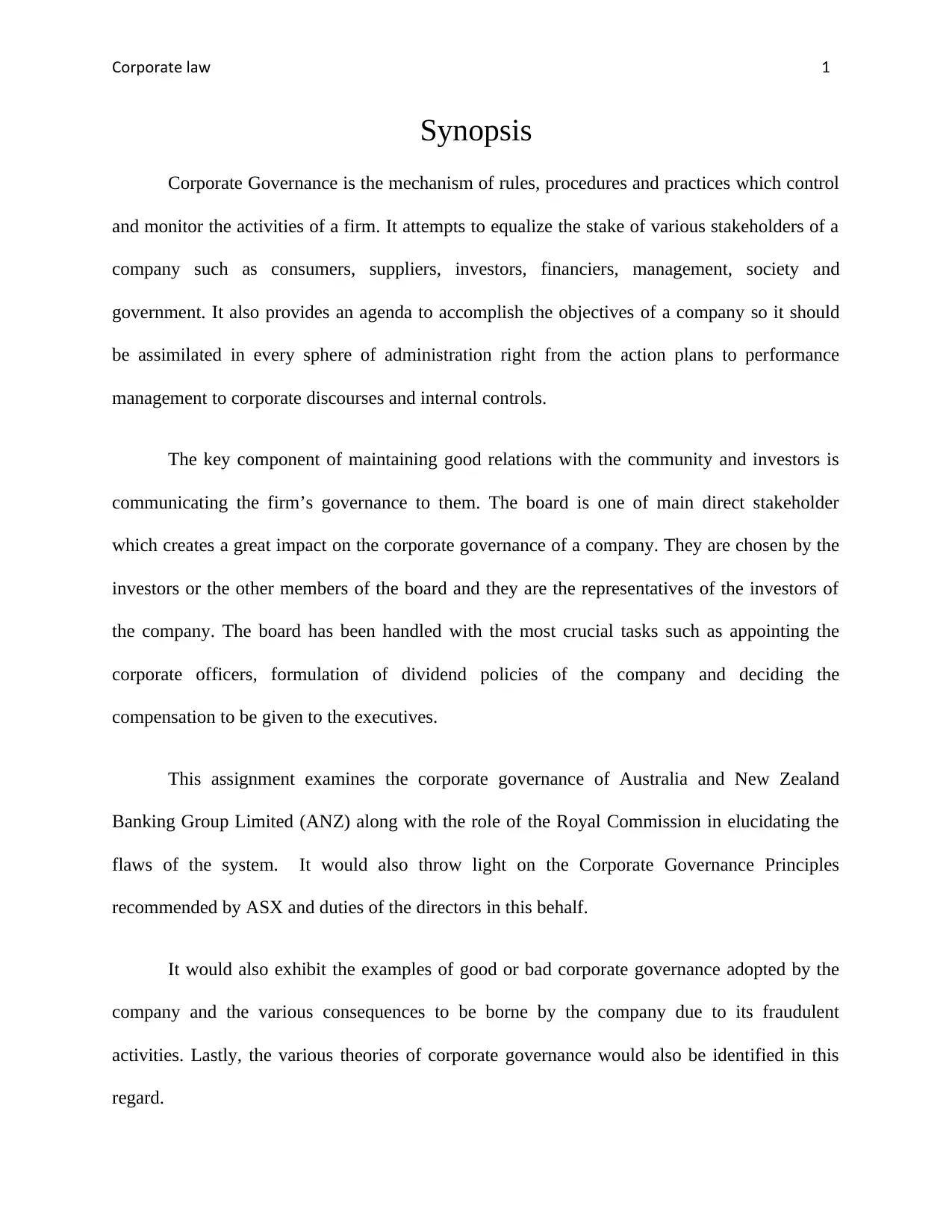
Corporate law 1
Synopsis
Corporate Governance is the mechanism of rules, procedures and practices which control
and monitor the activities of a firm. It attempts to equalize the stake of various stakeholders of a
company such as consumers, suppliers, investors, financiers, management, society and
government. It also provides an agenda to accomplish the objectives of a company so it should
be assimilated in every sphere of administration right from the action plans to performance
management to corporate discourses and internal controls.
The key component of maintaining good relations with the community and investors is
communicating the firm’s governance to them. The board is one of main direct stakeholder
which creates a great impact on the corporate governance of a company. They are chosen by the
investors or the other members of the board and they are the representatives of the investors of
the company. The board has been handled with the most crucial tasks such as appointing the
corporate officers, formulation of dividend policies of the company and deciding the
compensation to be given to the executives.
This assignment examines the corporate governance of Australia and New Zealand
Banking Group Limited (ANZ) along with the role of the Royal Commission in elucidating the
flaws of the system. It would also throw light on the Corporate Governance Principles
recommended by ASX and duties of the directors in this behalf.
It would also exhibit the examples of good or bad corporate governance adopted by the
company and the various consequences to be borne by the company due to its fraudulent
activities. Lastly, the various theories of corporate governance would also be identified in this
regard.
Synopsis
Corporate Governance is the mechanism of rules, procedures and practices which control
and monitor the activities of a firm. It attempts to equalize the stake of various stakeholders of a
company such as consumers, suppliers, investors, financiers, management, society and
government. It also provides an agenda to accomplish the objectives of a company so it should
be assimilated in every sphere of administration right from the action plans to performance
management to corporate discourses and internal controls.
The key component of maintaining good relations with the community and investors is
communicating the firm’s governance to them. The board is one of main direct stakeholder
which creates a great impact on the corporate governance of a company. They are chosen by the
investors or the other members of the board and they are the representatives of the investors of
the company. The board has been handled with the most crucial tasks such as appointing the
corporate officers, formulation of dividend policies of the company and deciding the
compensation to be given to the executives.
This assignment examines the corporate governance of Australia and New Zealand
Banking Group Limited (ANZ) along with the role of the Royal Commission in elucidating the
flaws of the system. It would also throw light on the Corporate Governance Principles
recommended by ASX and duties of the directors in this behalf.
It would also exhibit the examples of good or bad corporate governance adopted by the
company and the various consequences to be borne by the company due to its fraudulent
activities. Lastly, the various theories of corporate governance would also be identified in this
regard.
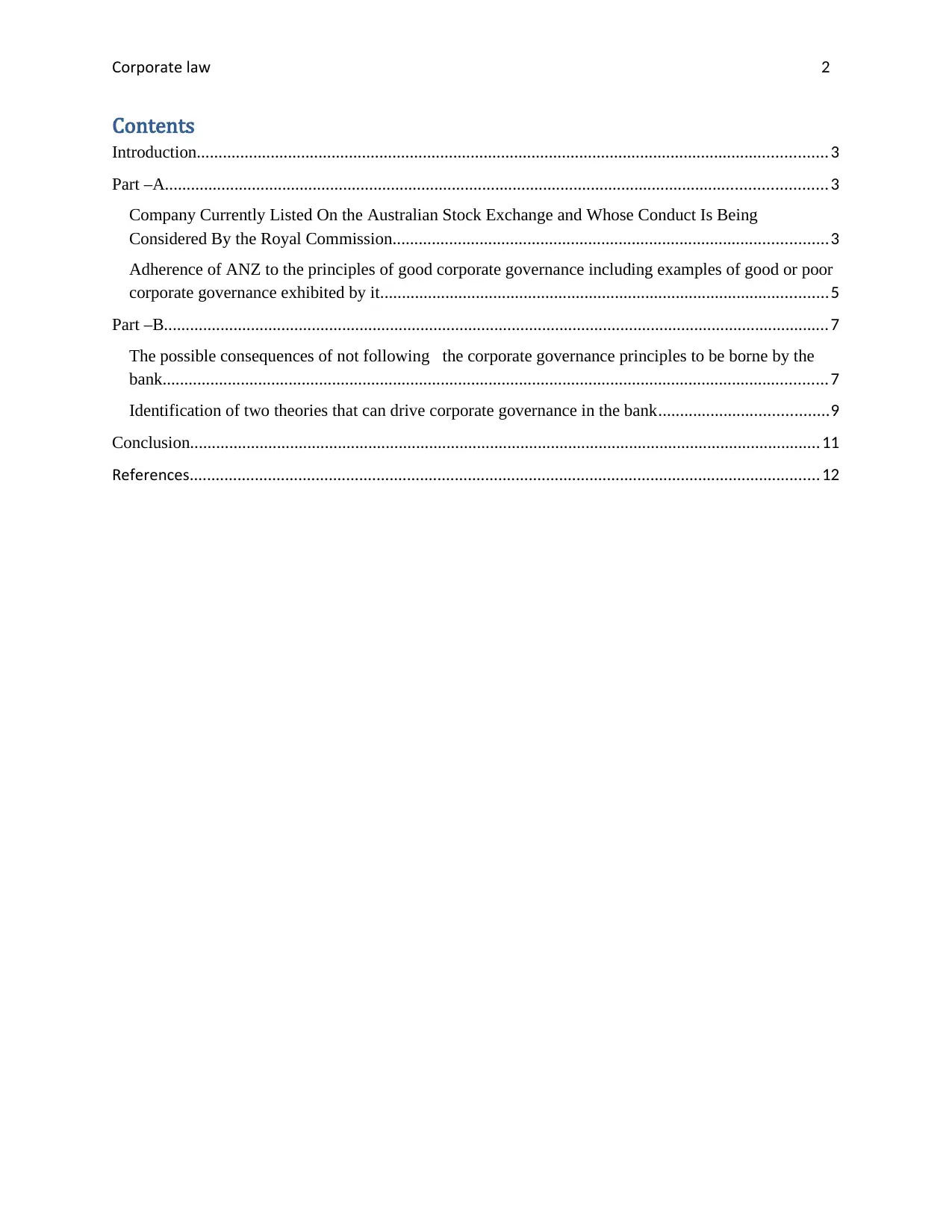
Corporate law 2
Contents
Introduction.................................................................................................................................................3
Part –A........................................................................................................................................................ 3
Company Currently Listed On the Australian Stock Exchange and Whose Conduct Is Being
Considered By the Royal Commission....................................................................................................3
Adherence of ANZ to the principles of good corporate governance including examples of good or poor
corporate governance exhibited by it.......................................................................................................5
Part –B......................................................................................................................................................... 7
The possible consequences of not following the corporate governance principles to be borne by the
bank......................................................................................................................................................... 7
Identification of two theories that can drive corporate governance in the bank.......................................9
Conclusion.................................................................................................................................................11
References.................................................................................................................................................12
Contents
Introduction.................................................................................................................................................3
Part –A........................................................................................................................................................ 3
Company Currently Listed On the Australian Stock Exchange and Whose Conduct Is Being
Considered By the Royal Commission....................................................................................................3
Adherence of ANZ to the principles of good corporate governance including examples of good or poor
corporate governance exhibited by it.......................................................................................................5
Part –B......................................................................................................................................................... 7
The possible consequences of not following the corporate governance principles to be borne by the
bank......................................................................................................................................................... 7
Identification of two theories that can drive corporate governance in the bank.......................................9
Conclusion.................................................................................................................................................11
References.................................................................................................................................................12
⊘ This is a preview!⊘
Do you want full access?
Subscribe today to unlock all pages.

Trusted by 1+ million students worldwide
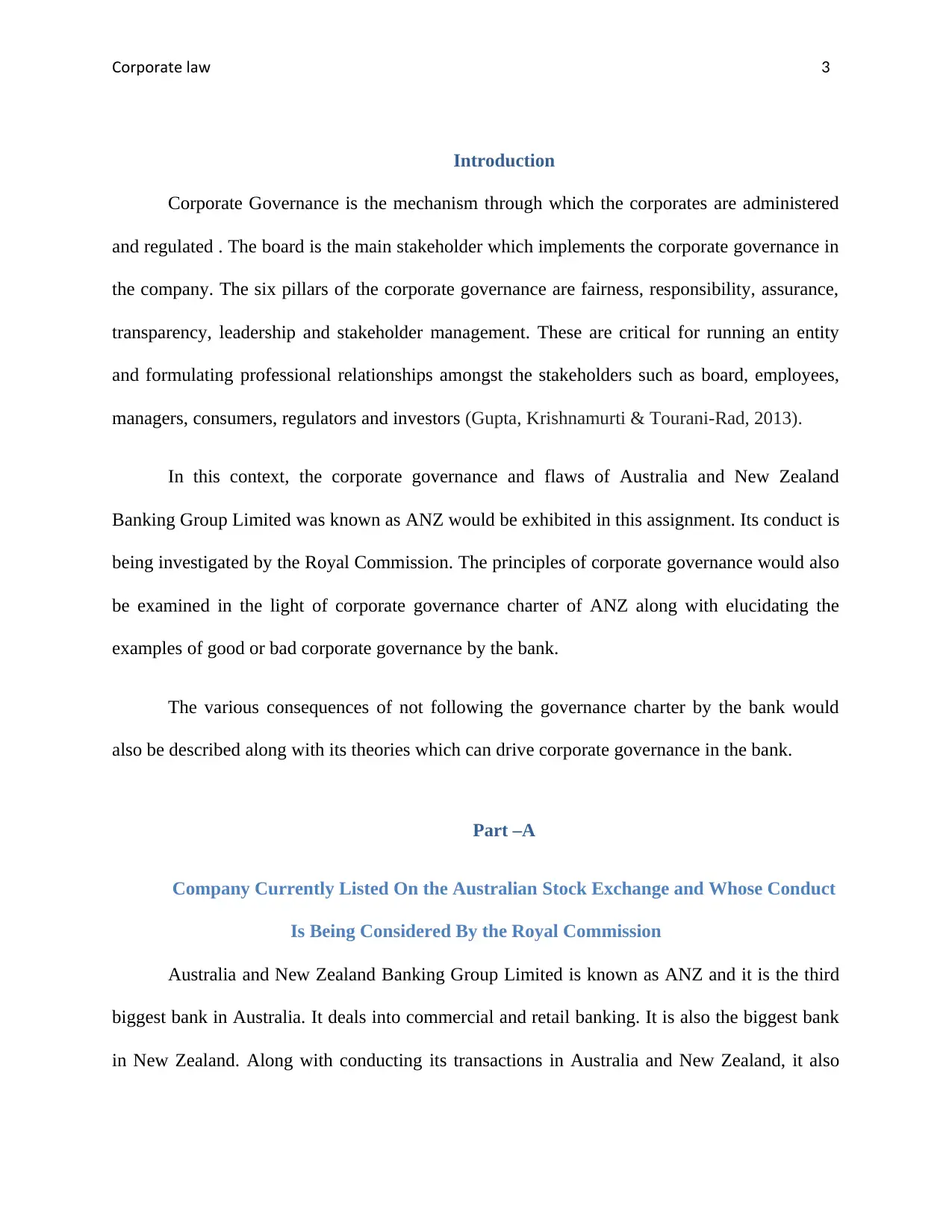
Corporate law 3
Introduction
Corporate Governance is the mechanism through which the corporates are administered
and regulated . The board is the main stakeholder which implements the corporate governance in
the company. The six pillars of the corporate governance are fairness, responsibility, assurance,
transparency, leadership and stakeholder management. These are critical for running an entity
and formulating professional relationships amongst the stakeholders such as board, employees,
managers, consumers, regulators and investors (Gupta, Krishnamurti & Tourani-Rad, 2013).
In this context, the corporate governance and flaws of Australia and New Zealand
Banking Group Limited was known as ANZ would be exhibited in this assignment. Its conduct is
being investigated by the Royal Commission. The principles of corporate governance would also
be examined in the light of corporate governance charter of ANZ along with elucidating the
examples of good or bad corporate governance by the bank.
The various consequences of not following the governance charter by the bank would
also be described along with its theories which can drive corporate governance in the bank.
Part –A
Company Currently Listed On the Australian Stock Exchange and Whose Conduct
Is Being Considered By the Royal Commission
Australia and New Zealand Banking Group Limited is known as ANZ and it is the third
biggest bank in Australia. It deals into commercial and retail banking. It is also the biggest bank
in New Zealand. Along with conducting its transactions in Australia and New Zealand, it also
Introduction
Corporate Governance is the mechanism through which the corporates are administered
and regulated . The board is the main stakeholder which implements the corporate governance in
the company. The six pillars of the corporate governance are fairness, responsibility, assurance,
transparency, leadership and stakeholder management. These are critical for running an entity
and formulating professional relationships amongst the stakeholders such as board, employees,
managers, consumers, regulators and investors (Gupta, Krishnamurti & Tourani-Rad, 2013).
In this context, the corporate governance and flaws of Australia and New Zealand
Banking Group Limited was known as ANZ would be exhibited in this assignment. Its conduct is
being investigated by the Royal Commission. The principles of corporate governance would also
be examined in the light of corporate governance charter of ANZ along with elucidating the
examples of good or bad corporate governance by the bank.
The various consequences of not following the governance charter by the bank would
also be described along with its theories which can drive corporate governance in the bank.
Part –A
Company Currently Listed On the Australian Stock Exchange and Whose Conduct
Is Being Considered By the Royal Commission
Australia and New Zealand Banking Group Limited is known as ANZ and it is the third
biggest bank in Australia. It deals into commercial and retail banking. It is also the biggest bank
in New Zealand. Along with conducting its transactions in Australia and New Zealand, it also
Paraphrase This Document
Need a fresh take? Get an instant paraphrase of this document with our AI Paraphraser
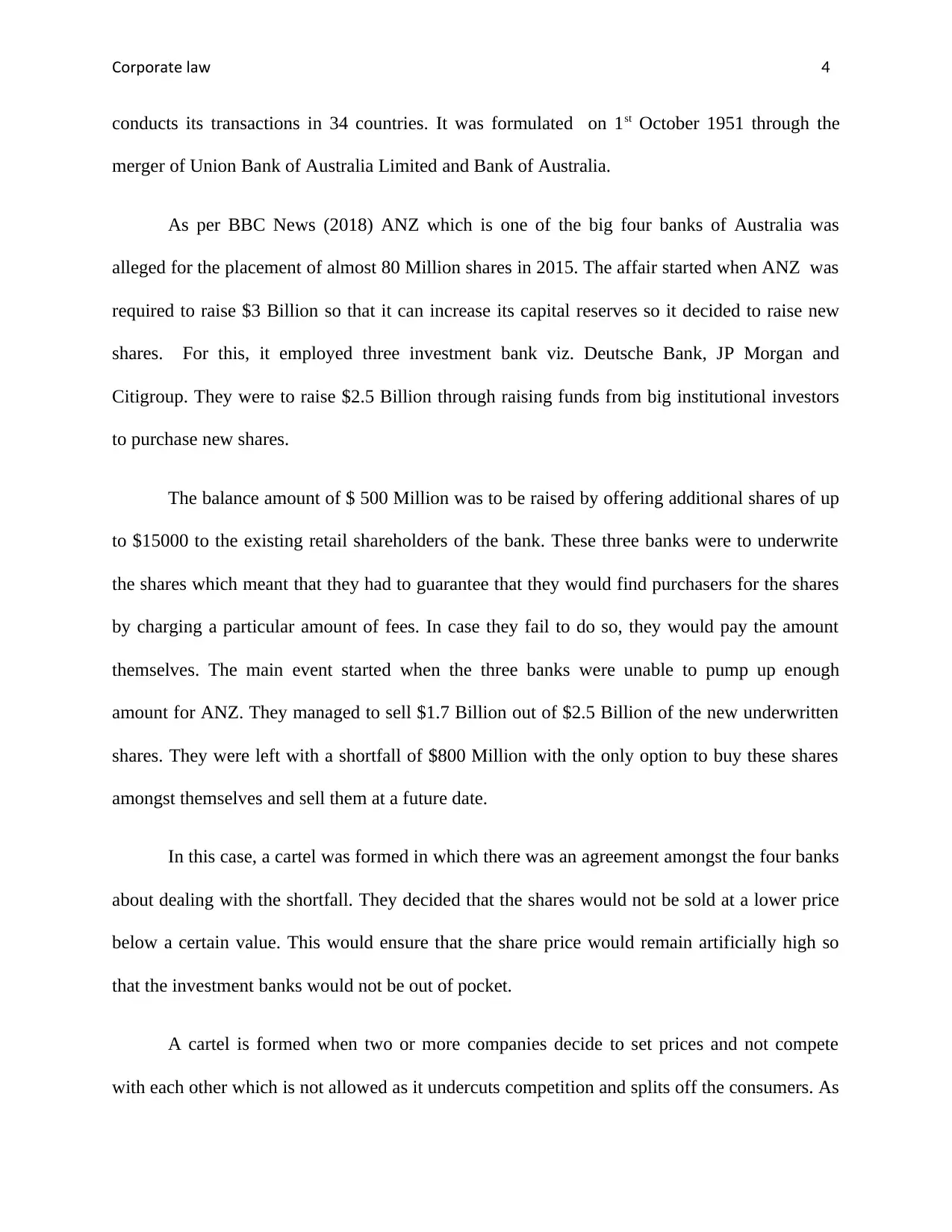
Corporate law 4
conducts its transactions in 34 countries. It was formulated on 1st October 1951 through the
merger of Union Bank of Australia Limited and Bank of Australia.
As per BBC News (2018) ANZ which is one of the big four banks of Australia was
alleged for the placement of almost 80 Million shares in 2015. The affair started when ANZ was
required to raise $3 Billion so that it can increase its capital reserves so it decided to raise new
shares. For this, it employed three investment bank viz. Deutsche Bank, JP Morgan and
Citigroup. They were to raise $2.5 Billion through raising funds from big institutional investors
to purchase new shares.
The balance amount of $ 500 Million was to be raised by offering additional shares of up
to $15000 to the existing retail shareholders of the bank. These three banks were to underwrite
the shares which meant that they had to guarantee that they would find purchasers for the shares
by charging a particular amount of fees. In case they fail to do so, they would pay the amount
themselves. The main event started when the three banks were unable to pump up enough
amount for ANZ. They managed to sell $1.7 Billion out of $2.5 Billion of the new underwritten
shares. They were left with a shortfall of $800 Million with the only option to buy these shares
amongst themselves and sell them at a future date.
In this case, a cartel was formed in which there was an agreement amongst the four banks
about dealing with the shortfall. They decided that the shares would not be sold at a lower price
below a certain value. This would ensure that the share price would remain artificially high so
that the investment banks would not be out of pocket.
A cartel is formed when two or more companies decide to set prices and not compete
with each other which is not allowed as it undercuts competition and splits off the consumers. As
conducts its transactions in 34 countries. It was formulated on 1st October 1951 through the
merger of Union Bank of Australia Limited and Bank of Australia.
As per BBC News (2018) ANZ which is one of the big four banks of Australia was
alleged for the placement of almost 80 Million shares in 2015. The affair started when ANZ was
required to raise $3 Billion so that it can increase its capital reserves so it decided to raise new
shares. For this, it employed three investment bank viz. Deutsche Bank, JP Morgan and
Citigroup. They were to raise $2.5 Billion through raising funds from big institutional investors
to purchase new shares.
The balance amount of $ 500 Million was to be raised by offering additional shares of up
to $15000 to the existing retail shareholders of the bank. These three banks were to underwrite
the shares which meant that they had to guarantee that they would find purchasers for the shares
by charging a particular amount of fees. In case they fail to do so, they would pay the amount
themselves. The main event started when the three banks were unable to pump up enough
amount for ANZ. They managed to sell $1.7 Billion out of $2.5 Billion of the new underwritten
shares. They were left with a shortfall of $800 Million with the only option to buy these shares
amongst themselves and sell them at a future date.
In this case, a cartel was formed in which there was an agreement amongst the four banks
about dealing with the shortfall. They decided that the shares would not be sold at a lower price
below a certain value. This would ensure that the share price would remain artificially high so
that the investment banks would not be out of pocket.
A cartel is formed when two or more companies decide to set prices and not compete
with each other which is not allowed as it undercuts competition and splits off the consumers. As
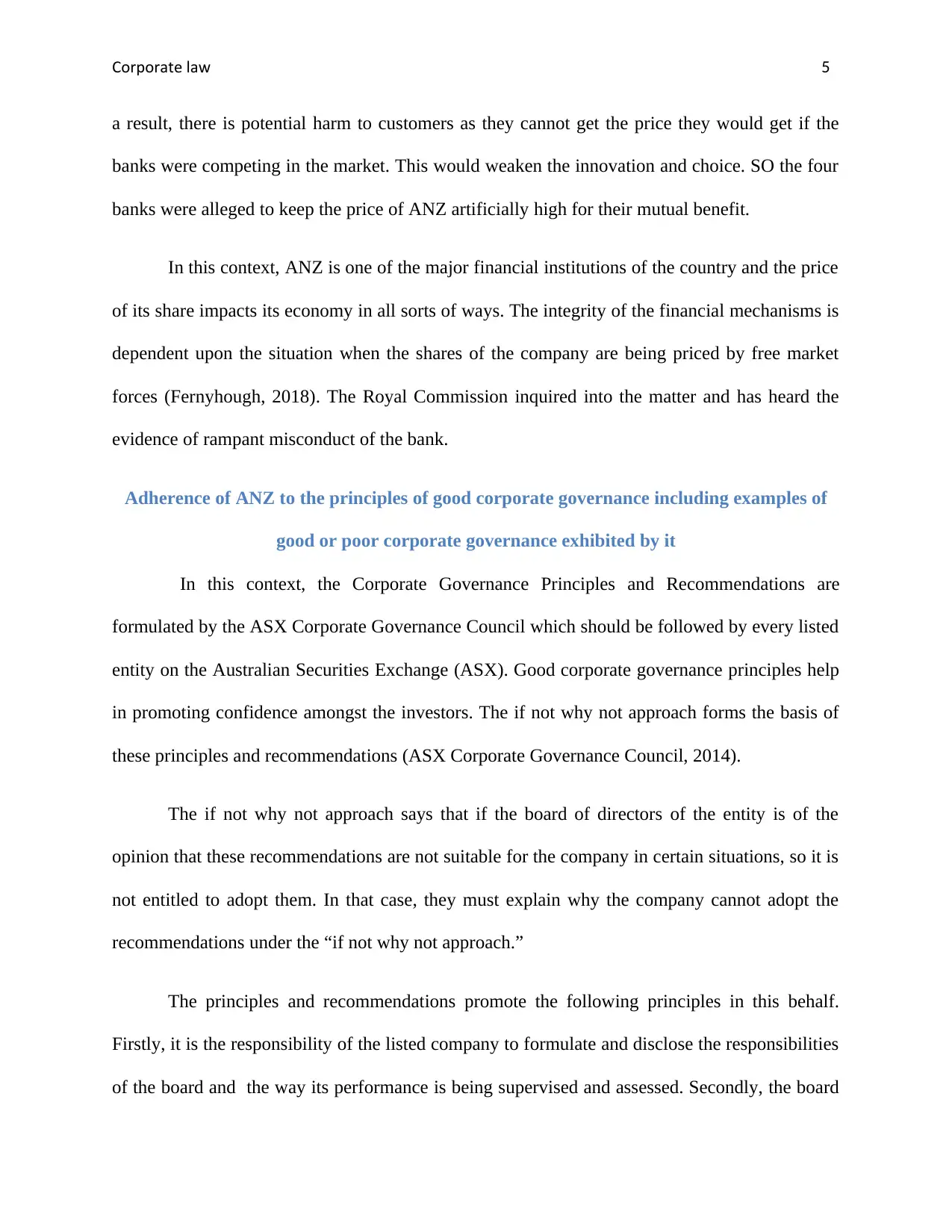
Corporate law 5
a result, there is potential harm to customers as they cannot get the price they would get if the
banks were competing in the market. This would weaken the innovation and choice. SO the four
banks were alleged to keep the price of ANZ artificially high for their mutual benefit.
In this context, ANZ is one of the major financial institutions of the country and the price
of its share impacts its economy in all sorts of ways. The integrity of the financial mechanisms is
dependent upon the situation when the shares of the company are being priced by free market
forces (Fernyhough, 2018). The Royal Commission inquired into the matter and has heard the
evidence of rampant misconduct of the bank.
Adherence of ANZ to the principles of good corporate governance including examples of
good or poor corporate governance exhibited by it
In this context, the Corporate Governance Principles and Recommendations are
formulated by the ASX Corporate Governance Council which should be followed by every listed
entity on the Australian Securities Exchange (ASX). Good corporate governance principles help
in promoting confidence amongst the investors. The if not why not approach forms the basis of
these principles and recommendations (ASX Corporate Governance Council, 2014).
The if not why not approach says that if the board of directors of the entity is of the
opinion that these recommendations are not suitable for the company in certain situations, so it is
not entitled to adopt them. In that case, they must explain why the company cannot adopt the
recommendations under the “if not why not approach.”
The principles and recommendations promote the following principles in this behalf.
Firstly, it is the responsibility of the listed company to formulate and disclose the responsibilities
of the board and the way its performance is being supervised and assessed. Secondly, the board
a result, there is potential harm to customers as they cannot get the price they would get if the
banks were competing in the market. This would weaken the innovation and choice. SO the four
banks were alleged to keep the price of ANZ artificially high for their mutual benefit.
In this context, ANZ is one of the major financial institutions of the country and the price
of its share impacts its economy in all sorts of ways. The integrity of the financial mechanisms is
dependent upon the situation when the shares of the company are being priced by free market
forces (Fernyhough, 2018). The Royal Commission inquired into the matter and has heard the
evidence of rampant misconduct of the bank.
Adherence of ANZ to the principles of good corporate governance including examples of
good or poor corporate governance exhibited by it
In this context, the Corporate Governance Principles and Recommendations are
formulated by the ASX Corporate Governance Council which should be followed by every listed
entity on the Australian Securities Exchange (ASX). Good corporate governance principles help
in promoting confidence amongst the investors. The if not why not approach forms the basis of
these principles and recommendations (ASX Corporate Governance Council, 2014).
The if not why not approach says that if the board of directors of the entity is of the
opinion that these recommendations are not suitable for the company in certain situations, so it is
not entitled to adopt them. In that case, they must explain why the company cannot adopt the
recommendations under the “if not why not approach.”
The principles and recommendations promote the following principles in this behalf.
Firstly, it is the responsibility of the listed company to formulate and disclose the responsibilities
of the board and the way its performance is being supervised and assessed. Secondly, the board
⊘ This is a preview!⊘
Do you want full access?
Subscribe today to unlock all pages.

Trusted by 1+ million students worldwide
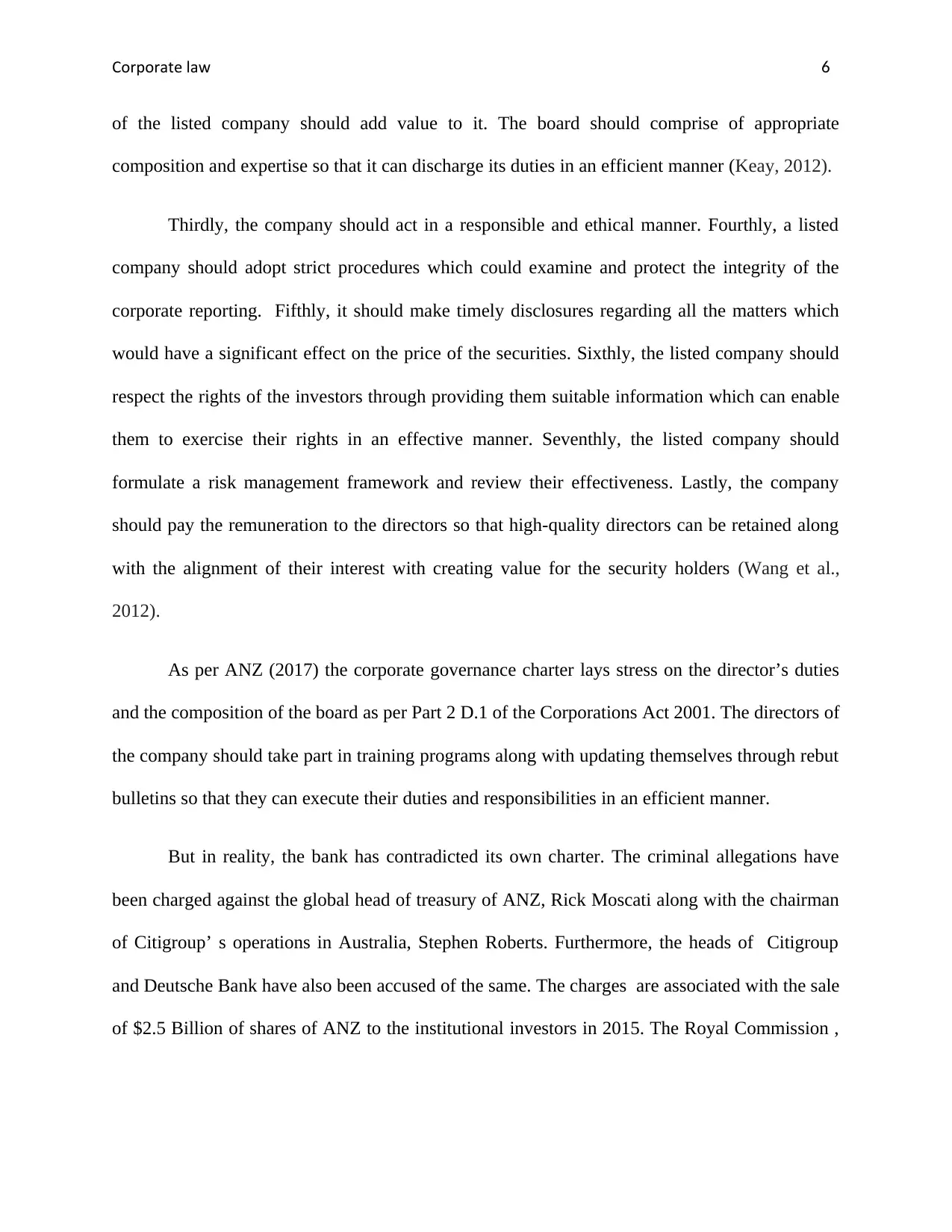
Corporate law 6
of the listed company should add value to it. The board should comprise of appropriate
composition and expertise so that it can discharge its duties in an efficient manner (Keay, 2012).
Thirdly, the company should act in a responsible and ethical manner. Fourthly, a listed
company should adopt strict procedures which could examine and protect the integrity of the
corporate reporting. Fifthly, it should make timely disclosures regarding all the matters which
would have a significant effect on the price of the securities. Sixthly, the listed company should
respect the rights of the investors through providing them suitable information which can enable
them to exercise their rights in an effective manner. Seventhly, the listed company should
formulate a risk management framework and review their effectiveness. Lastly, the company
should pay the remuneration to the directors so that high-quality directors can be retained along
with the alignment of their interest with creating value for the security holders (Wang et al.,
2012).
As per ANZ (2017) the corporate governance charter lays stress on the director’s duties
and the composition of the board as per Part 2 D.1 of the Corporations Act 2001. The directors of
the company should take part in training programs along with updating themselves through rebut
bulletins so that they can execute their duties and responsibilities in an efficient manner.
But in reality, the bank has contradicted its own charter. The criminal allegations have
been charged against the global head of treasury of ANZ, Rick Moscati along with the chairman
of Citigroup’ s operations in Australia, Stephen Roberts. Furthermore, the heads of Citigroup
and Deutsche Bank have also been accused of the same. The charges are associated with the sale
of $2.5 Billion of shares of ANZ to the institutional investors in 2015. The Royal Commission ,
of the listed company should add value to it. The board should comprise of appropriate
composition and expertise so that it can discharge its duties in an efficient manner (Keay, 2012).
Thirdly, the company should act in a responsible and ethical manner. Fourthly, a listed
company should adopt strict procedures which could examine and protect the integrity of the
corporate reporting. Fifthly, it should make timely disclosures regarding all the matters which
would have a significant effect on the price of the securities. Sixthly, the listed company should
respect the rights of the investors through providing them suitable information which can enable
them to exercise their rights in an effective manner. Seventhly, the listed company should
formulate a risk management framework and review their effectiveness. Lastly, the company
should pay the remuneration to the directors so that high-quality directors can be retained along
with the alignment of their interest with creating value for the security holders (Wang et al.,
2012).
As per ANZ (2017) the corporate governance charter lays stress on the director’s duties
and the composition of the board as per Part 2 D.1 of the Corporations Act 2001. The directors of
the company should take part in training programs along with updating themselves through rebut
bulletins so that they can execute their duties and responsibilities in an efficient manner.
But in reality, the bank has contradicted its own charter. The criminal allegations have
been charged against the global head of treasury of ANZ, Rick Moscati along with the chairman
of Citigroup’ s operations in Australia, Stephen Roberts. Furthermore, the heads of Citigroup
and Deutsche Bank have also been accused of the same. The charges are associated with the sale
of $2.5 Billion of shares of ANZ to the institutional investors in 2015. The Royal Commission ,
Paraphrase This Document
Need a fresh take? Get an instant paraphrase of this document with our AI Paraphraser
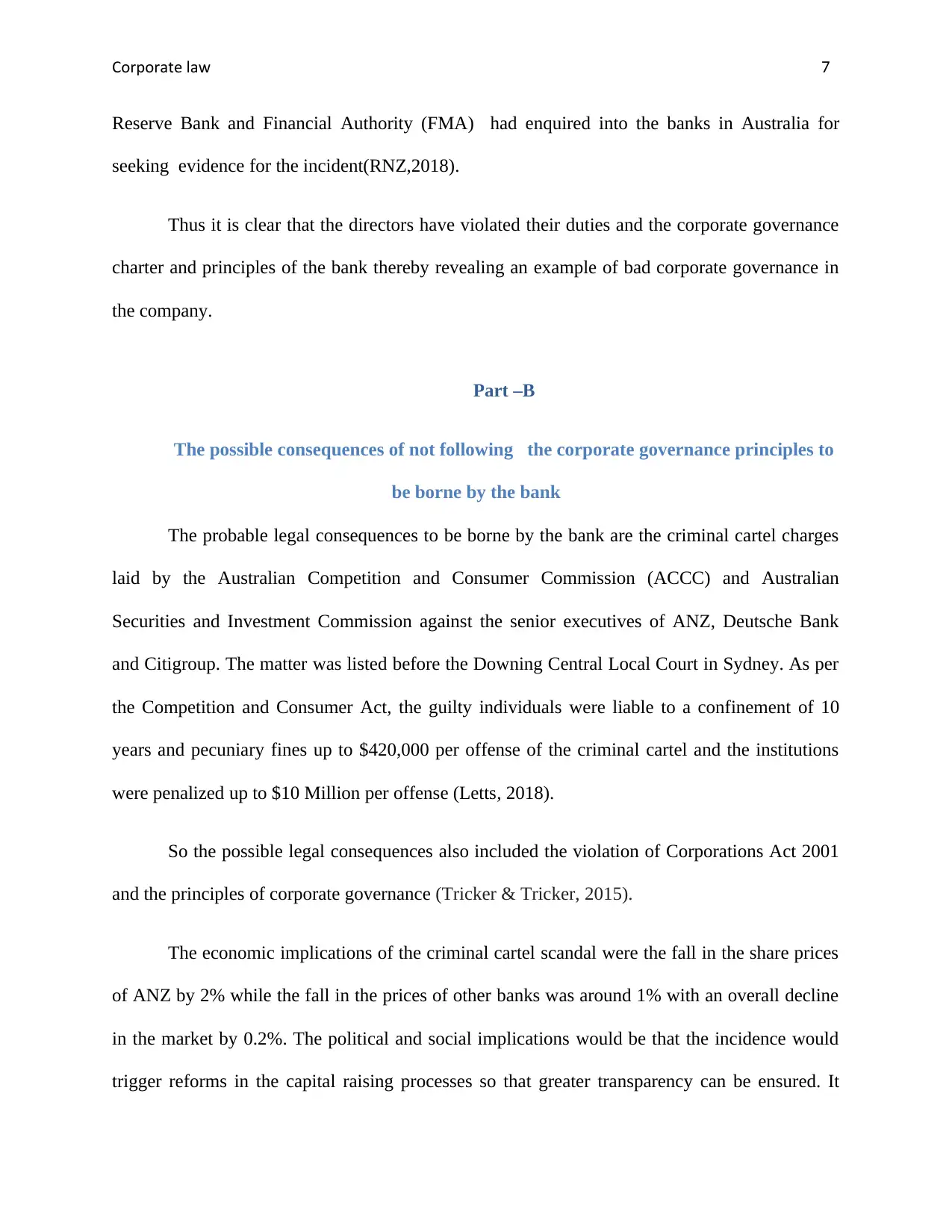
Corporate law 7
Reserve Bank and Financial Authority (FMA) had enquired into the banks in Australia for
seeking evidence for the incident(RNZ,2018).
Thus it is clear that the directors have violated their duties and the corporate governance
charter and principles of the bank thereby revealing an example of bad corporate governance in
the company.
Part –B
The possible consequences of not following the corporate governance principles to
be borne by the bank
The probable legal consequences to be borne by the bank are the criminal cartel charges
laid by the Australian Competition and Consumer Commission (ACCC) and Australian
Securities and Investment Commission against the senior executives of ANZ, Deutsche Bank
and Citigroup. The matter was listed before the Downing Central Local Court in Sydney. As per
the Competition and Consumer Act, the guilty individuals were liable to a confinement of 10
years and pecuniary fines up to $420,000 per offense of the criminal cartel and the institutions
were penalized up to $10 Million per offense (Letts, 2018).
So the possible legal consequences also included the violation of Corporations Act 2001
and the principles of corporate governance (Tricker & Tricker, 2015).
The economic implications of the criminal cartel scandal were the fall in the share prices
of ANZ by 2% while the fall in the prices of other banks was around 1% with an overall decline
in the market by 0.2%. The political and social implications would be that the incidence would
trigger reforms in the capital raising processes so that greater transparency can be ensured. It
Reserve Bank and Financial Authority (FMA) had enquired into the banks in Australia for
seeking evidence for the incident(RNZ,2018).
Thus it is clear that the directors have violated their duties and the corporate governance
charter and principles of the bank thereby revealing an example of bad corporate governance in
the company.
Part –B
The possible consequences of not following the corporate governance principles to
be borne by the bank
The probable legal consequences to be borne by the bank are the criminal cartel charges
laid by the Australian Competition and Consumer Commission (ACCC) and Australian
Securities and Investment Commission against the senior executives of ANZ, Deutsche Bank
and Citigroup. The matter was listed before the Downing Central Local Court in Sydney. As per
the Competition and Consumer Act, the guilty individuals were liable to a confinement of 10
years and pecuniary fines up to $420,000 per offense of the criminal cartel and the institutions
were penalized up to $10 Million per offense (Letts, 2018).
So the possible legal consequences also included the violation of Corporations Act 2001
and the principles of corporate governance (Tricker & Tricker, 2015).
The economic implications of the criminal cartel scandal were the fall in the share prices
of ANZ by 2% while the fall in the prices of other banks was around 1% with an overall decline
in the market by 0.2%. The political and social implications would be that the incidence would
trigger reforms in the capital raising processes so that greater transparency can be ensured. It
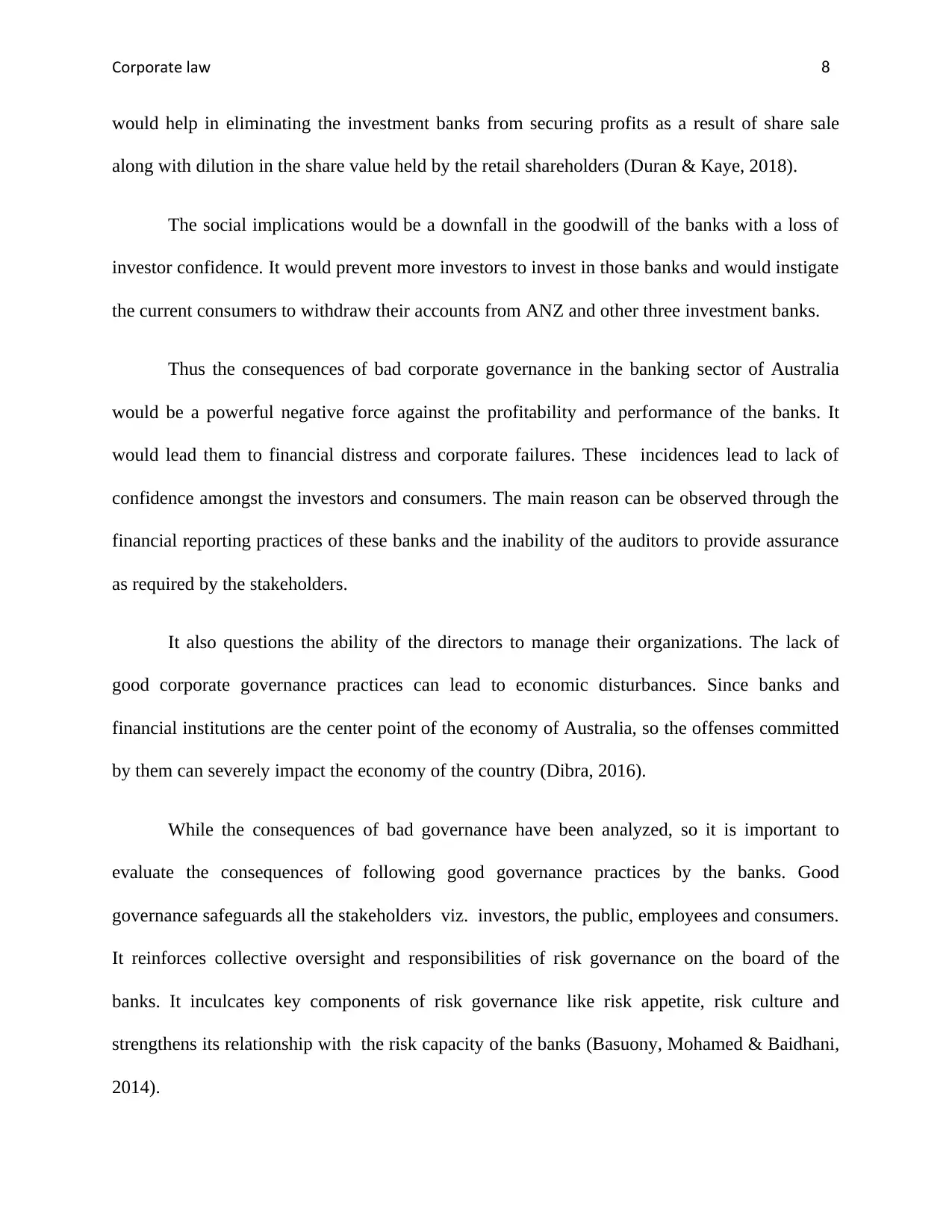
Corporate law 8
would help in eliminating the investment banks from securing profits as a result of share sale
along with dilution in the share value held by the retail shareholders (Duran & Kaye, 2018).
The social implications would be a downfall in the goodwill of the banks with a loss of
investor confidence. It would prevent more investors to invest in those banks and would instigate
the current consumers to withdraw their accounts from ANZ and other three investment banks.
Thus the consequences of bad corporate governance in the banking sector of Australia
would be a powerful negative force against the profitability and performance of the banks. It
would lead them to financial distress and corporate failures. These incidences lead to lack of
confidence amongst the investors and consumers. The main reason can be observed through the
financial reporting practices of these banks and the inability of the auditors to provide assurance
as required by the stakeholders.
It also questions the ability of the directors to manage their organizations. The lack of
good corporate governance practices can lead to economic disturbances. Since banks and
financial institutions are the center point of the economy of Australia, so the offenses committed
by them can severely impact the economy of the country (Dibra, 2016).
While the consequences of bad governance have been analyzed, so it is important to
evaluate the consequences of following good governance practices by the banks. Good
governance safeguards all the stakeholders viz. investors, the public, employees and consumers.
It reinforces collective oversight and responsibilities of risk governance on the board of the
banks. It inculcates key components of risk governance like risk appetite, risk culture and
strengthens its relationship with the risk capacity of the banks (Basuony, Mohamed & Baidhani,
2014).
would help in eliminating the investment banks from securing profits as a result of share sale
along with dilution in the share value held by the retail shareholders (Duran & Kaye, 2018).
The social implications would be a downfall in the goodwill of the banks with a loss of
investor confidence. It would prevent more investors to invest in those banks and would instigate
the current consumers to withdraw their accounts from ANZ and other three investment banks.
Thus the consequences of bad corporate governance in the banking sector of Australia
would be a powerful negative force against the profitability and performance of the banks. It
would lead them to financial distress and corporate failures. These incidences lead to lack of
confidence amongst the investors and consumers. The main reason can be observed through the
financial reporting practices of these banks and the inability of the auditors to provide assurance
as required by the stakeholders.
It also questions the ability of the directors to manage their organizations. The lack of
good corporate governance practices can lead to economic disturbances. Since banks and
financial institutions are the center point of the economy of Australia, so the offenses committed
by them can severely impact the economy of the country (Dibra, 2016).
While the consequences of bad governance have been analyzed, so it is important to
evaluate the consequences of following good governance practices by the banks. Good
governance safeguards all the stakeholders viz. investors, the public, employees and consumers.
It reinforces collective oversight and responsibilities of risk governance on the board of the
banks. It inculcates key components of risk governance like risk appetite, risk culture and
strengthens its relationship with the risk capacity of the banks (Basuony, Mohamed & Baidhani,
2014).
⊘ This is a preview!⊘
Do you want full access?
Subscribe today to unlock all pages.

Trusted by 1+ million students worldwide
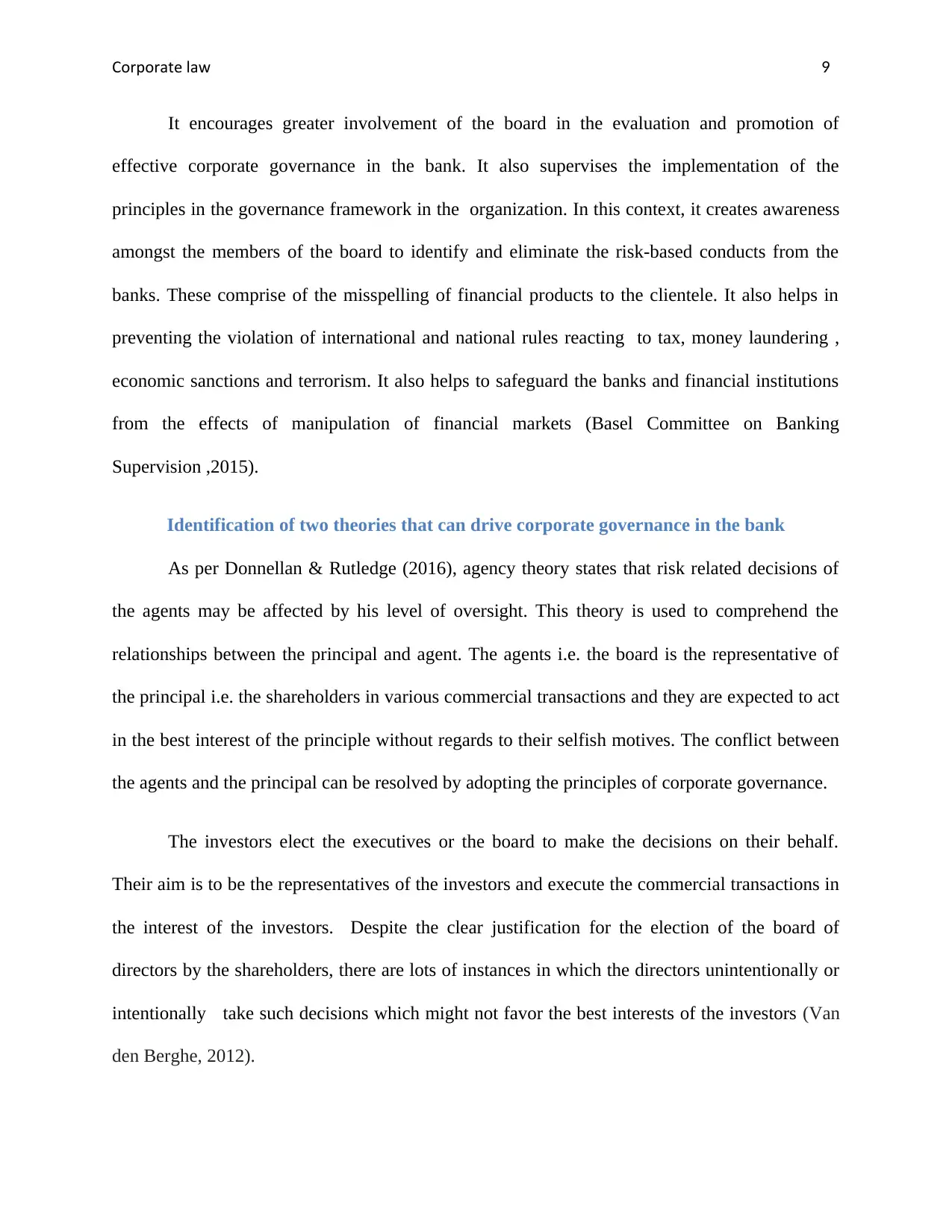
Corporate law 9
It encourages greater involvement of the board in the evaluation and promotion of
effective corporate governance in the bank. It also supervises the implementation of the
principles in the governance framework in the organization. In this context, it creates awareness
amongst the members of the board to identify and eliminate the risk-based conducts from the
banks. These comprise of the misspelling of financial products to the clientele. It also helps in
preventing the violation of international and national rules reacting to tax, money laundering ,
economic sanctions and terrorism. It also helps to safeguard the banks and financial institutions
from the effects of manipulation of financial markets (Basel Committee on Banking
Supervision ,2015).
Identification of two theories that can drive corporate governance in the bank
As per Donnellan & Rutledge (2016), agency theory states that risk related decisions of
the agents may be affected by his level of oversight. This theory is used to comprehend the
relationships between the principal and agent. The agents i.e. the board is the representative of
the principal i.e. the shareholders in various commercial transactions and they are expected to act
in the best interest of the principle without regards to their selfish motives. The conflict between
the agents and the principal can be resolved by adopting the principles of corporate governance.
The investors elect the executives or the board to make the decisions on their behalf.
Their aim is to be the representatives of the investors and execute the commercial transactions in
the interest of the investors. Despite the clear justification for the election of the board of
directors by the shareholders, there are lots of instances in which the directors unintentionally or
intentionally take such decisions which might not favor the best interests of the investors (Van
den Berghe, 2012).
It encourages greater involvement of the board in the evaluation and promotion of
effective corporate governance in the bank. It also supervises the implementation of the
principles in the governance framework in the organization. In this context, it creates awareness
amongst the members of the board to identify and eliminate the risk-based conducts from the
banks. These comprise of the misspelling of financial products to the clientele. It also helps in
preventing the violation of international and national rules reacting to tax, money laundering ,
economic sanctions and terrorism. It also helps to safeguard the banks and financial institutions
from the effects of manipulation of financial markets (Basel Committee on Banking
Supervision ,2015).
Identification of two theories that can drive corporate governance in the bank
As per Donnellan & Rutledge (2016), agency theory states that risk related decisions of
the agents may be affected by his level of oversight. This theory is used to comprehend the
relationships between the principal and agent. The agents i.e. the board is the representative of
the principal i.e. the shareholders in various commercial transactions and they are expected to act
in the best interest of the principle without regards to their selfish motives. The conflict between
the agents and the principal can be resolved by adopting the principles of corporate governance.
The investors elect the executives or the board to make the decisions on their behalf.
Their aim is to be the representatives of the investors and execute the commercial transactions in
the interest of the investors. Despite the clear justification for the election of the board of
directors by the shareholders, there are lots of instances in which the directors unintentionally or
intentionally take such decisions which might not favor the best interests of the investors (Van
den Berghe, 2012).
Paraphrase This Document
Need a fresh take? Get an instant paraphrase of this document with our AI Paraphraser
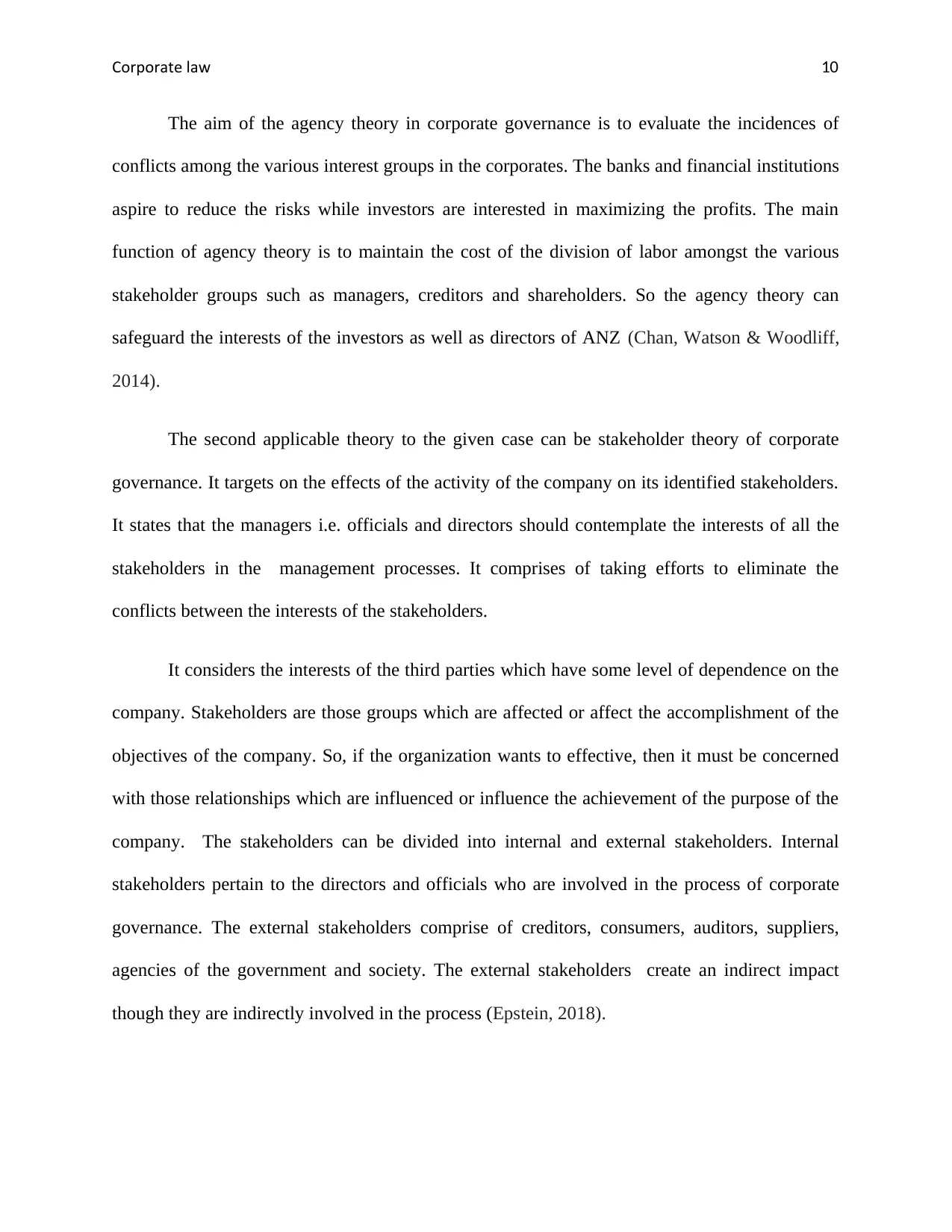
Corporate law 10
The aim of the agency theory in corporate governance is to evaluate the incidences of
conflicts among the various interest groups in the corporates. The banks and financial institutions
aspire to reduce the risks while investors are interested in maximizing the profits. The main
function of agency theory is to maintain the cost of the division of labor amongst the various
stakeholder groups such as managers, creditors and shareholders. So the agency theory can
safeguard the interests of the investors as well as directors of ANZ (Chan, Watson & Woodliff,
2014).
The second applicable theory to the given case can be stakeholder theory of corporate
governance. It targets on the effects of the activity of the company on its identified stakeholders.
It states that the managers i.e. officials and directors should contemplate the interests of all the
stakeholders in the management processes. It comprises of taking efforts to eliminate the
conflicts between the interests of the stakeholders.
It considers the interests of the third parties which have some level of dependence on the
company. Stakeholders are those groups which are affected or affect the accomplishment of the
objectives of the company. So, if the organization wants to effective, then it must be concerned
with those relationships which are influenced or influence the achievement of the purpose of the
company. The stakeholders can be divided into internal and external stakeholders. Internal
stakeholders pertain to the directors and officials who are involved in the process of corporate
governance. The external stakeholders comprise of creditors, consumers, auditors, suppliers,
agencies of the government and society. The external stakeholders create an indirect impact
though they are indirectly involved in the process (Epstein, 2018).
The aim of the agency theory in corporate governance is to evaluate the incidences of
conflicts among the various interest groups in the corporates. The banks and financial institutions
aspire to reduce the risks while investors are interested in maximizing the profits. The main
function of agency theory is to maintain the cost of the division of labor amongst the various
stakeholder groups such as managers, creditors and shareholders. So the agency theory can
safeguard the interests of the investors as well as directors of ANZ (Chan, Watson & Woodliff,
2014).
The second applicable theory to the given case can be stakeholder theory of corporate
governance. It targets on the effects of the activity of the company on its identified stakeholders.
It states that the managers i.e. officials and directors should contemplate the interests of all the
stakeholders in the management processes. It comprises of taking efforts to eliminate the
conflicts between the interests of the stakeholders.
It considers the interests of the third parties which have some level of dependence on the
company. Stakeholders are those groups which are affected or affect the accomplishment of the
objectives of the company. So, if the organization wants to effective, then it must be concerned
with those relationships which are influenced or influence the achievement of the purpose of the
company. The stakeholders can be divided into internal and external stakeholders. Internal
stakeholders pertain to the directors and officials who are involved in the process of corporate
governance. The external stakeholders comprise of creditors, consumers, auditors, suppliers,
agencies of the government and society. The external stakeholders create an indirect impact
though they are indirectly involved in the process (Epstein, 2018).
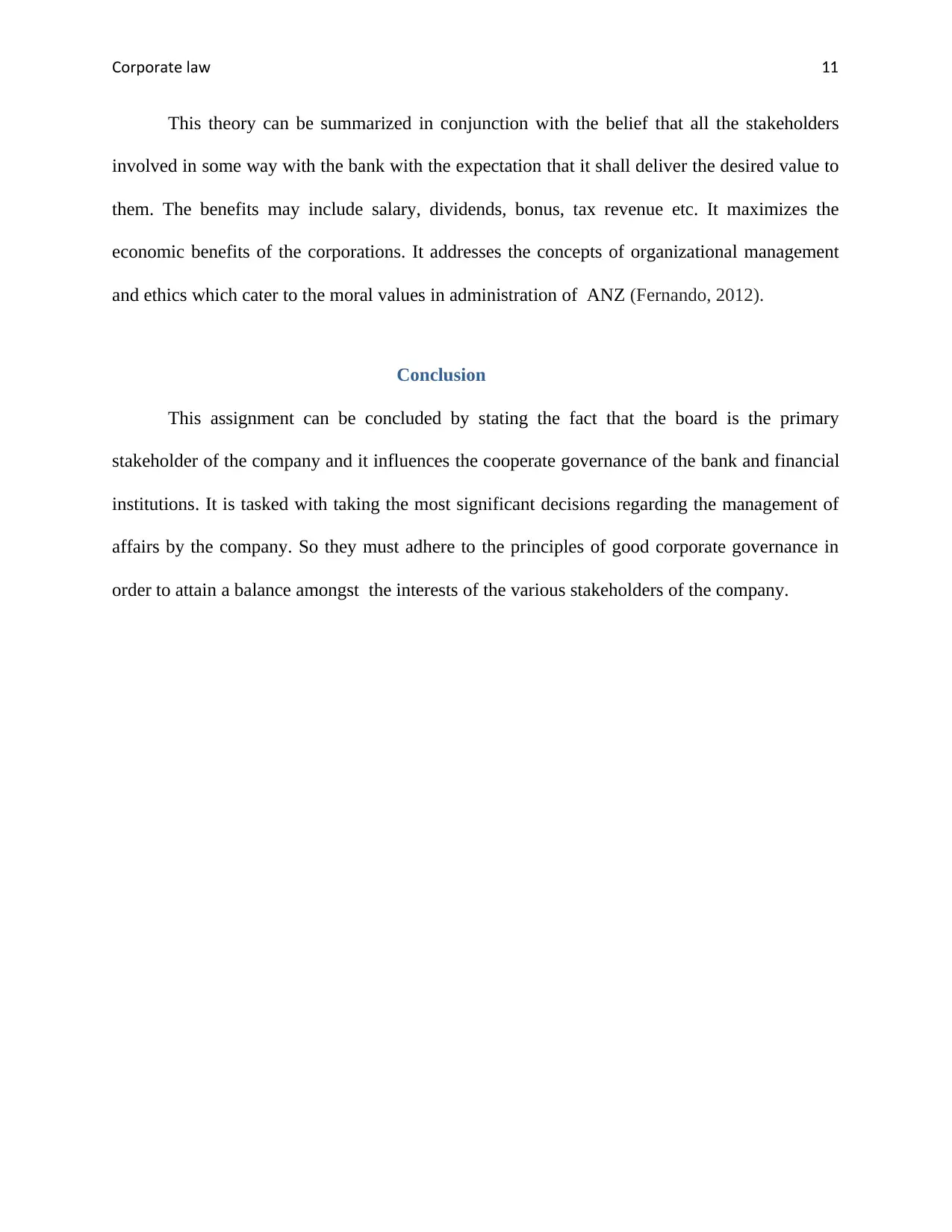
Corporate law 11
This theory can be summarized in conjunction with the belief that all the stakeholders
involved in some way with the bank with the expectation that it shall deliver the desired value to
them. The benefits may include salary, dividends, bonus, tax revenue etc. It maximizes the
economic benefits of the corporations. It addresses the concepts of organizational management
and ethics which cater to the moral values in administration of ANZ (Fernando, 2012).
Conclusion
This assignment can be concluded by stating the fact that the board is the primary
stakeholder of the company and it influences the cooperate governance of the bank and financial
institutions. It is tasked with taking the most significant decisions regarding the management of
affairs by the company. So they must adhere to the principles of good corporate governance in
order to attain a balance amongst the interests of the various stakeholders of the company.
This theory can be summarized in conjunction with the belief that all the stakeholders
involved in some way with the bank with the expectation that it shall deliver the desired value to
them. The benefits may include salary, dividends, bonus, tax revenue etc. It maximizes the
economic benefits of the corporations. It addresses the concepts of organizational management
and ethics which cater to the moral values in administration of ANZ (Fernando, 2012).
Conclusion
This assignment can be concluded by stating the fact that the board is the primary
stakeholder of the company and it influences the cooperate governance of the bank and financial
institutions. It is tasked with taking the most significant decisions regarding the management of
affairs by the company. So they must adhere to the principles of good corporate governance in
order to attain a balance amongst the interests of the various stakeholders of the company.
⊘ This is a preview!⊘
Do you want full access?
Subscribe today to unlock all pages.

Trusted by 1+ million students worldwide
1 out of 15
Related Documents
Your All-in-One AI-Powered Toolkit for Academic Success.
+13062052269
info@desklib.com
Available 24*7 on WhatsApp / Email
![[object Object]](/_next/static/media/star-bottom.7253800d.svg)
Unlock your academic potential
Copyright © 2020–2025 A2Z Services. All Rights Reserved. Developed and managed by ZUCOL.



